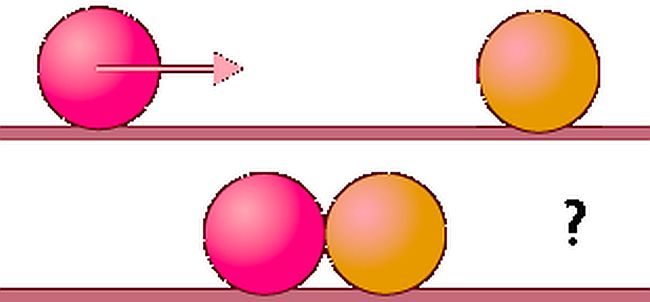Collisions, explosions and impulse
Momentum and collisions
Momentum is a vector quantity which is always conserved in the absence of external forces.What this means is that the total momentum of a system in the absence of external forces will be the same before any collision and after it.
When answering examination questions it is vital to remember that we have to state the TOTAL momentum of all objects before collision will be equal to the TOTAL momentum of all objects after collsion in the ABSENCE of external forces.
Momentum is calculated using the following equation: This tells us the momentum is the prouct of mass and velocity.
Example
A ball of mass 200 g moving at 4 ms-1 collides with a stationary ball of mass 100 g. The ball that was hit moves with a velocity of 3 ms-1. What is the velocity of the 200 g ball after the collision?
Conservation of momentum can be applied as there are no external forces.
Total momentum before collision can be calculated for each ball and then added together.
Momentum of 200 g ball:
Momentum of 100 g ball:
Total mmomentum is therefore:
After the collision we know the velocity of one ball, but not the other. Since we already know the total momentum it is possible to calculate the unknown velocity.
Momentum of the 100 g ball after collision
Momentum of 200 g ball after collision
Now we know the momentum of the 200 g ball we can work out its velocity.
Determining the speed of the ball
Attempt to solve the question yourself before clicking the solve button!
Elastic Collisions
When a collision occurs the kinetic energy of the objects can be conserved. Where this occurs we have a collision that is said to be perfectly elastic. An example of such a collision is given below.
Elastic Collision Example

A billiard ball of mass 155 g collides with a sationary ball with the same mass. The moving ball has an initial velocity of 2.5 m/s. After collision this ball is stationary. The ball that was hit by the moving ball is now moving at 2.5 m/s. Show that the momentum is conserved and that the collision is elastic.
Since the question uses the command word "show" we must begin our answer by using the appropriate equation.
and When we show that the total momentum before collision is the same as the total momentum after collision the first part of the question will have been answered.
Before Collision
After Collision
Since these values are the same we have shown that the momentum has been conserved.
To show that the collision is elastic we need to determine if the kinetic energy in the system before the collision is the same as the kinetic energy in the system after the collision. Since the command term show has been used we must begin the answer with the appropriate equation. And we should also write the equation for total kinetic energy in the system Before Collision After Collision
From this we can see that the kinetic energy before the collision is the same as the kinetic energy after the collision. In the absence of any external forces this means that this is an elastic collision.
Inelastic Collision
When a collision occurs and the kinetic energy of the objects is converted to an energy other than kinetic this is said to be an inelastic collision. An example of such a collision is given below.

Two cars are moving in opposite directions. The car moving to the right has a mass of 1500 kg and is travelling at 5 m/s. The car moving to the left has a mass of 2000 kg and is moving at 3 m/s.
The cars stick to each other in the collision and move as a combined object. What speed and direction are the cars moving in after the collision? Show that this is an inelastic collision.
To solve the first part of the question we need to remember that in the absence of external forces the momentum after the collision will equal the momentum before the collision.
Now consider the after situation:
This value is positive, so that cars move to the right at 0.43 ms-1 immediately after the collision.
To show that this is an inelastic collision we need to work out the total kinetic energy before the the collision, and the total kinetic energy after the collision. An inelastic collision will result in a smaller kinetic energy after the collision.
Because the question states that we must SHOW we must first write the equation that we will use.
Before Collision After CollisionNotice how much kinetic energy has been "lost". You should understand that this has been transferred to the deformation of the cars, heat and sound in the collision.
Elastic or inelastic
Attempt to solve the question yourself before clicking the solve button!
Recoiling Collision
Attempt to solve the question yourself before clicking the solve button!
Inelastic Collision
Attempt to solve the question yourself before clicking the solve button!
Linear Momentum and Collisions PowerPoint
Elastic and Inelastic Collisions
Force and Impulse